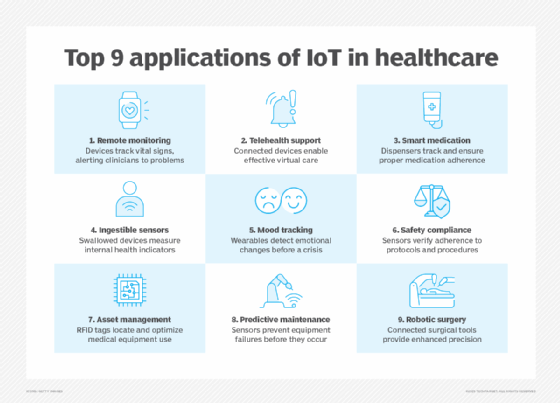Top 9 applications of IoT in healthcare
IoT in healthcare powers remote monitoring, telehealth, smart medication, mood tracking, safety compliance, robotic surgery and predictive maintenance for better care.
The use of IoT technologies in healthcare has grown significantly over the past decade and is expected to keep growing in the years ahead.
One report from The Business Research Company put the healthcare IoT market at $231.71 billion in 2024 and predicted it will hit $282.23 billion in 2025 and then $616.29 billion in 2029. That's a compound annual growth rate of 21.6%.
The transformative power of IoT in healthcare, the demonstrative benefits IoT offers to patients and the overall digital transformation happening in the medical industry all contribute to significant growth.
IoT in the healthcare sector, also called the internet of medical things (IoMT), includes various technologies: sensors that collect patient biometric data, networks that transmit data and computers that process the data.
When those technologies come together in an IoT environment, they enable patients and their healthcare providers to analyze and respond to data in near real time. This offers a level of accuracy and speed that was impossible without that technology.
Top applications of IoT in healthcare
Healthcare entities use IoMT in myriad ways to improve clinical operations, patient experiences and patient outcomes. Here are nine use cases of IoT in healthcare.
1. Remote patient monitoring
RPM is among the most common and visible examples of IoT in healthcare. Patients use devices to measure or monitor one or more vital signs -- i.e., heart rate, blood pressure, glucose levels and temperature.
The device can send the metrics to a care team's computer systems for review and analysis at regular intervals, or the metrics can only be sent outside of preset parameters, which could indicate medical issues requiring attention.
For example, IoT-enabled monitoring can be set up to alert clinicians if a smart thermometer detects a fever in a patient recovering from surgery at home, as a rise in temperature could signal an infection. Patients and their healthcare teams can also analyze collected data to help diagnose conditions or gain insights into existing ones.
All these uses aim to help keep patients as healthy as possible and ensure timely treatment of acute issues if they occur.
2. Telehealth enablement
IoMT is also essential for many virtual medical visits and telehealth capabilities. Using connected medical devices -- from consumer-grade wearable health trackers to connected imaging systems -- for monitoring, collecting and transmitting patient data in real time enables more effective virtual consultations and telehealth care.
This speeds up the delivery of care and treatment to homebound and rural patients and reduces costly hospital visits.
3. Medication management and adherence
Connected medical dispensers, such as inhalers, insulin pens and pill containers, can be programmed to remind patients when to take their medicine and to dispense the proper dosage at the right time. Moreover, these connected dispensers can track whether patients took their medication and send reports to the care team.
This real-world data is more accurate than self-reporting from patients, and it helps both patients and clinical teams manage even complex medication schedules, ensure adherence to treatment plans and prevent errors -- all of which improve patient outcomes.
4. Ingestible sensors
These are small IoMT-enabled devices that patients swallow. The devices enter and pass through the gastrointestinal tract, where they measure temperature, pH levels and other health indicators using biosensors.
They are typically powered by microbatteries, biofuel cells or energy harvested from the body's environment. Wireless telemetry transmits data clinicians can use to diagnose conditions without performing more invasive procedures, such as endoscopy.

5. Mood monitoring
Healthcare providers also use connected devices for mood monitoring and management, finding that IoMT can provide accurate, real-time information about a patient's feelings.
The use of IoMT here involves wearable devices, biosensors, mobile apps and AI programs designed to recognize emotions and physiological signals indicating certain moods.
IoMT for mood monitoring and management can detect subtle changes in mental health, alert patients and caregivers of those changes and help determine whether and what interventions are needed -- ideally before patients experience a crisis.
6. Enforcing safety policies and best practices, including hand hygiene monitoring
IoMT is also used to ensure that personnel follow safety protocols, policies and best practices. For example, a hospital can use RFID tags, wearable badges and sensors to track staff movements to confirm they adhere to infectious disease control measures or mandated hand hygiene procedures.
A doctor's office can use environmental sensors to monitor temperature and humidity to ensure proper medication storage. In such cases, medical institutions can use wireless communication technology, such as Bluetooth Low Energy (BLE), to transmit data from endpoints to central compute resources like the cloud, where systems analyze data and produce reports on compliance levels.
7. Equipment and asset tracking, monitoring and maintenance
The healthcare industry uses IoT technologies to monitor equipment and assets, too, mirroring the use of IoT in other sectors such as manufacturing and logistics.
Healthcare institutions can attach smart sensors, RFID tags or BLE beacons to medical equipment, such as portable X-ray machines or wheelchairs, enabling real-time location tracking from centralized dashboards. This use of IoT reduces equipment loss and optimizes inventory management.
8. Predictive maintenance
Like many others, the healthcare industry also uses IoT technologies to enable a proactive approach to maintaining its equipment and assets.
Sensors on medical equipment and other assets gather data about the usage and condition of the machines. The sensors then send this data to computers, which combine it with information from different sources -- such as those provided by the machine manufacturers -- to determine the precise timing for maintenance.
This enables healthcare institutions to optimize maintenance schedules, keep equipment operating at peak performance and prevent breakdowns that could affect patient care.
9. Robotic surgery
Surgeons are harnessing the power of IoMT to perform operations more efficiently and effectively. For example, they use monitoring devices and analytics programs for advanced real-time monitoring during surgeries.
They also use connected surgical devices with AI-enabled computer vision and robotic capabilities for improved visualization and precision. These technologies automatically adjust to changing conditions, increasing the chances for positive patient outcomes.
Future of IoT in healthcare
The healthcare industry is at the early stages of using IoT to transform its care delivery, with researchers and healthcare leaders reporting that advances in connected systems, AI and robotics are poised to revolutionize the sector.
These technologies could help lower costs while further improving patient engagement, the patient experience, the clinician experience and -- most importantly -- patient outcomes.
Mary K. Pratt is an award-winning freelance journalist with a focus on covering enterprise IT and cybersecurity management.








